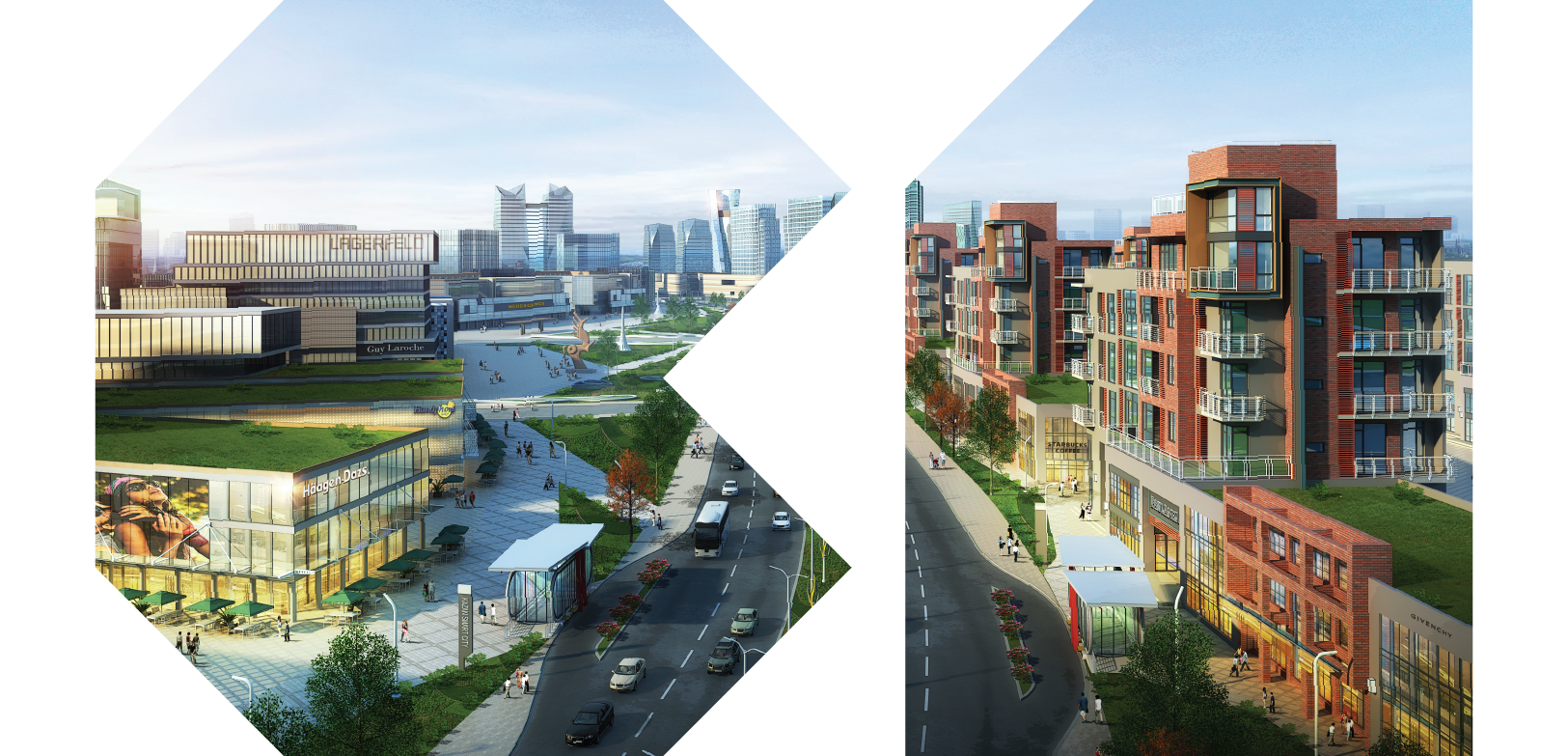There is a history of the future written in renderings; images of fantasy assembled as marketing, escapism and policy toolkits.
Images of ‘the’ future hold a powerful grasp over the things we orient towards as we innovate and disrupt our way to a receding hyper-real horizon.1 For example, the relationship between science fiction and technological development is well documented as an ever looping feedback cycle where Spielbergian gadgets and interfaces are seen as beacons of aspiration for those who populate Las Vegas’ yearly Consumer Electronics Show and in turn, the latest trinkets appearing in the breathless pages of WIRED magazine go on to become props and talking points for the critical eye of cinema.2 There is even compelling arguments that it is the grounding of those who run the world’s most successful companies in a childhood combination of ‘Star Trek’ and ‘Dungeons and Dragons’ that has resulted in this quantitative, gadgetized and globally rolled out vision of the future.3
But at a city scale this relationship between fantasy visions and actual development is harder to track, largely because of the scale of time and space involved. Say ‘future city’ and for most folk the first image is probably something from the background of a Star Trek set. White and steel gleaming towers, people as silhouettes out of a Lowry painting, no mess, no fuss. Roofs and balconies overflow with green and traffic seeming to have vanished.4 These hyper-real fantasy renders are beginning to be questioned and critiqued by the architecture world. For one, they pose a risk to investment if the reality fails to live up to the rendering,5 notably in the use of aspirational tropes like birds and trees or,6 as I’ve started to notice more and more, balloons.7 Olly Wainwright, in a recent Guardian piece, criticized architecture with the ‘intent on fleeing the real world of people and places, scale and context; retreating instead into fantasy realms of convoluted forms with no seeming purpose.’8
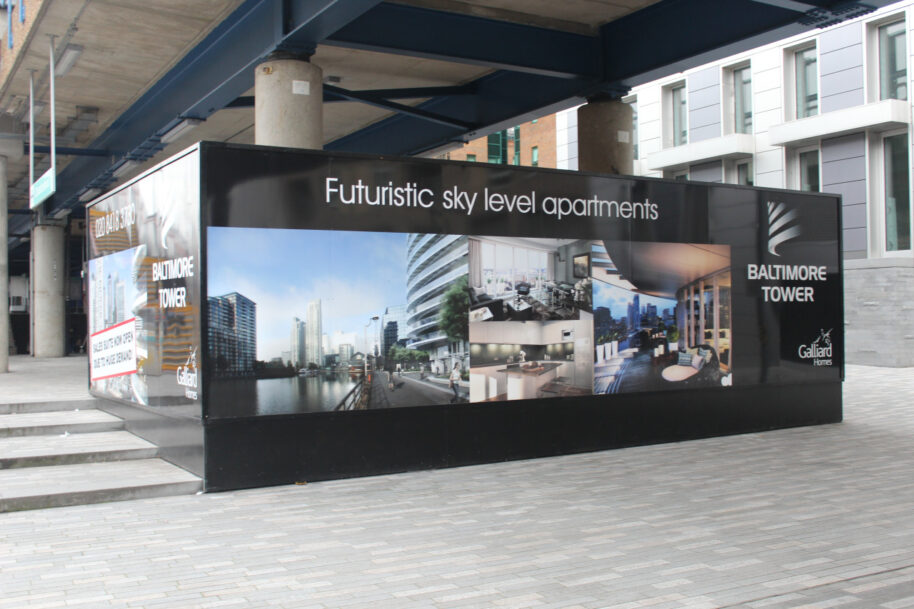
Context is queen here. These renderings live outside of any recognizable universe. Like concept cars these renderings are devoid of background and where there is one, it is generic, half-realized, serving to thrust the subject into the foreground and beg the viewer to ignore any of the details about how this future vision will integrate with the present.9 Many projects have been set up to critique and criticize our rendered futures. Crystal Bennes’s excellent hashtag ‘#DevelopmentAesthetics’ takes a tongue-in-cheek crack at the literary and visual language of development hoardings. Where Dan Hill describes planning notices as the most important civic document we can interface with, I would argue that development hoardings are the second.10 These massive wooden walls block off the future-in-construction and proudly proclaim the social and cultural transformations to come, blind to the city around them, forcibly separating interaction.
What is beginning to be more and more interesting is the way that these rendered future visions are built and the alternative potentials in the tools that are used to construct them.
The artist Matthew Plummer-Fernandez has highlighted the relationship between rendering software and the shape of buildings, describing how stock curves and forms found in software packages are starting to shape the city.11 Similar to the relationship between science fiction and cinema, the renderings produced out of these software packages go back into informing their development, reinforcing the aesthetic biases inherent in the programs and visions. A similar phenomenon of data-based aesthetic reinforcement is theorized to have occurred within pop music – the ‘Shazam Effect.’12 By rendering our futures we run the risk of a clipping distance on our vision.13 (While walking through the insane re-development of Elephant and Castle in London, I joked to a friend that the fog that day was caused by the software unable to render so many new buildings at once.) This collapse of the physical and the software world is also examined and critiqued in the architectural theorist Keller Easterling’s seminal work ‘Extrastatecraft’14 and in Rob Kitchin and Martin Dodge’s ‘Code/Space’15 where they describe how spaces like airports and similar physical spaces are entirely shaped around the functioning of software packages. While work like James Bridle’s ‘Render Ghost Search’ seeks to reconcile the software future vision and the unknowingly constituted people and parts.16

Other projects seek to push this relationship between the software and built worlds to a point of absurdity in order to highlight the relationship. Lawrence Lek’s prize-winning ‘Unreal Estate (the Royal Academy is yours)’ is a fantasy played out through a game engine in which we, the audience, are the new oligarch owners of the Royal Academy, with limitless control over wealth and the laws of physics.17 At a base level, ‘Unreal Estate’ is a Moore-style Utopia locked in a game world but also a way of seeing the world, which Lek implies is insidiously real for the very wealthiest.
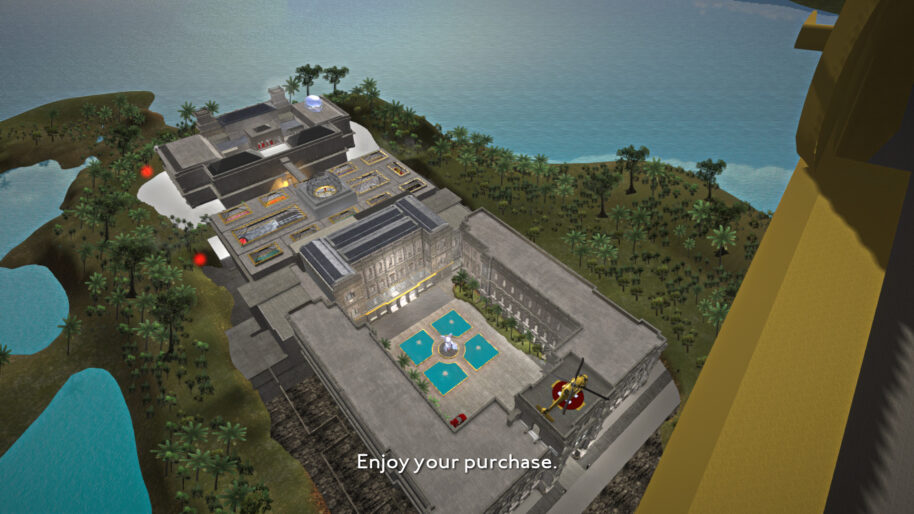
Beyond the dream of living in these rendered future fantasies, the act of rendering itself is a privileged activity. It requires several components; the time and education to imagine compelling futures and then the time and education required to learn the skills to represent these imaginaries in visual form. If technology could be defined as the combination of tools and the knowledge of techniques on the application of those tools then inventing the future is a combination of its imagination and its rendering. And though there is a long and convoluted history of the architectural drawing, 3D rendering software is the most common tool used by architects and students today.
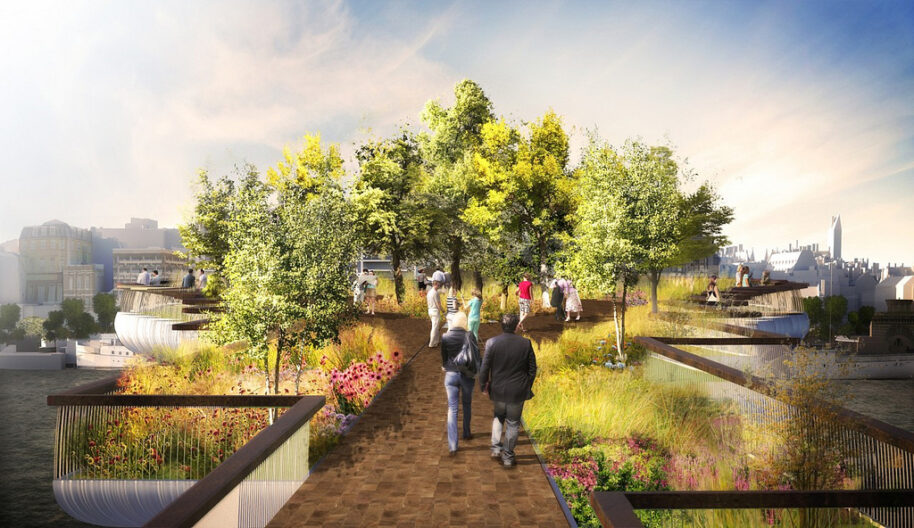
Protests and vocalizations against developments and top-down imaginaries are inevitably protests at the renders of these imaginaries. For example, every article about the controversy swarming the Garden Bridge in London features a render of it accompanied by vague promises of the rules and functions that would be rendered into effect on its completion.18 The same image over and over again, reinforcing the inevitability of our future built.19 There is a difference between a render, which is one actor’s imagined future, and the way that that future will actually play out, but due to the commonality and cultural assimilation of rendering, these two ideas have become conflated. We have built a culture of resistance to renders. A future is presented as a glossy, gleaming spire and we almost dutifully express outrage towards its generic structure and gentrifying effect, nostalgic for the world before. Very few renders evoke hope and aspiration at street level because they are harbingers of someone else’s ideal of your built future.
In their recent book ‘Inventing the Future’ Nick Srnicek and Alex Williams lambast the ‘folk politics’ of local resistance.20 They cite the death of revolutionary politics and talk about how the failure to provide compelling alternatives and imagine futures to build toward has created a set of victory conditions for neoliberalism. They are not the first to call for the seizing of imagination to invent the future and in my last piece for Amateur Cities I too, extolled the virtues of imagination in building alternatives.21
But these imaginary visions need to be more than challenges and critiques, we need to move past the point of using rendering techniques to ‘challenge the future’ to ask ‘what if?’ or to ‘render the invisible visible’ and begin inventing it:a seizing of the means of rendering.22
If our future is steered by rendered beacons then we need to create our own desirable renders to move toward; a utopian paradigm for a set of fields that have spent the last few decades tirelessly critiquing and resisting. At some point, critical approaches to architecture and design rejected the ‘utopia’ as an icon of control, a myth used to make false promises of technologies. Paul Graham-Raven has compellingly argued that a place does exist for utopia, that it still performs as a useful trope in talking about the future.23 Utopia is, of course, still impossible and in this way it fits within the language of rendering – impossibly perfect images that defy the laws of physics.
The point is to make our own impossibly aspirational imagery, to flood the future with a multiplicity of imaginable alternatives that undermine the validity of the futures being rendered and built.
These tools are difficult, 3D software is a tough thing to learn. We are told that we all must learn to code as it is the language of the future and there is something to be said about knowing the source code of the future.24 But we are also realizing that our future will be increasingly seen and consumed through 3D rendering – virtual and augmented realities, the creep of CGI into everything and increasingly powerful consumer hardware are making convincing hyper-realities more and more a part of the world’s visual vocabulary. These rendered imaginaries will shape our expectations of the future as we continue to exist in a feeling of timelessness.
The tools are difficult but they are multiplying, Google Sketchup is becoming more sophisticated as a free alternative to other engines. Beyond traditional rendering platforms, Minecraft has already proven its worth as an educational and imaginative platform, allowing players to stretch the bounds of the rules of the universe.
It is not clear what a radical utopian rendering culture would look like, nor exactly how these things would act outside of the existing culture of architectural renderings, developing things not to appeal to developers or critics. Sascha Pohflepp’s recent work with physics engines, provokes thoughts of a Dr Morel-style world where rendering technology frees us from the bounds of the physical universe rather than constructing more visions of monoliths and shopping centres.25 Imaging these worlds in the context of cheapening immersive and virtual realities opens up massive possibilities for radically reforming reality and constructing radically different spaces.
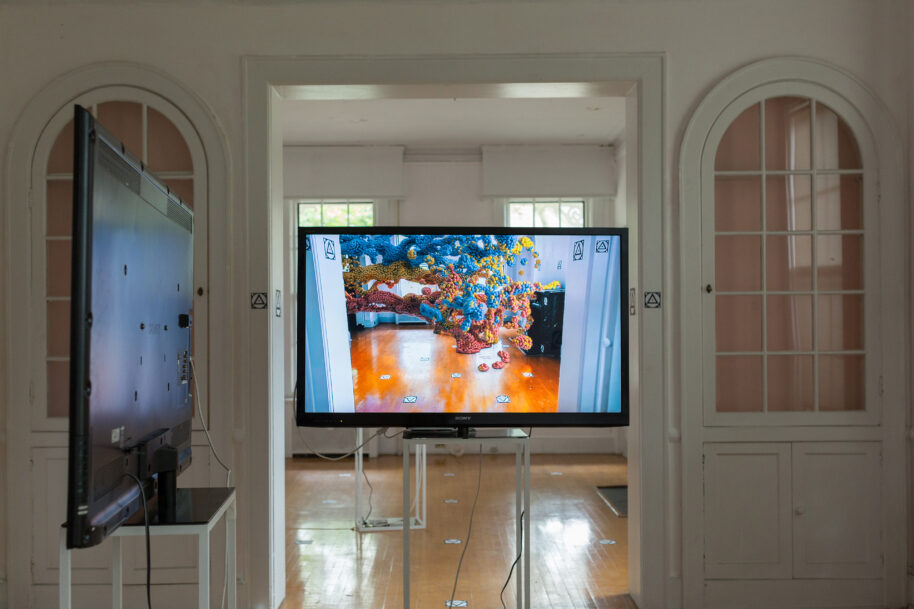
The work of 3D artists such as Alan Warburton’s CGWTF and Nikita Diakur’s Ugly Universe, amongst many others, start to suggest how rendering tools can be turned against their creators and used perversely to break the physics and rendering engines that are prebuilt for beautiful architectural usage. Matthew Plummer-Fernandez’s portfolio of work has sought to build imaginaries for how 3D software might free us from our existing capitalist frameworks. The possibilities of this software goes far beyond the perfect rendered tree and glossy glass facade, it extends to simulating entire new rules for physics, creating unimaginable materials and realizing impossible structures. These projects go further than the quasi-speculative works seen at architectural exhibitions and graduate shows. They channel the tools into broadening our definitions of utopia.
The major barrier to entry on the possibilities of alternate renders is of course technological. Whatever form, these renders require some sort of interface; a gallery, a screen, a laptop, the Internet. All things that the mainstream future-makers can bypass through hoardings and press pieces.
In this increasingly powerful and more accessible suite of tools lies a way of not just critiquing, not just imagining but rendering a future vision to orient ourselves toward. The privilege of these tools is crumbling and their purpose is being challenged. Render unto Caesar, what is Caesar’s.
- Revell, T., ‘Smart City Dreamin’ presentation at Transmediale Berlin (2016) ↩
- assett C., Steinmueller E., Voss G., Better Made Up: The Mutual Influence of Science fiction and Innovation, Nesta working paper (2013)], [Kirby, D.A, Lab Coats in Hollywood – Science, Scientists, and Cinema (Cambridge, MA: MIT Press, 2011) ↩
- Graeber, D., The Utopia of Rules: On Technology, Stupidity, and the Secret Joys of Bureaucracy (New York: Melville House, 2015) ↩
- Minkjan, M., ‘What this MVRDV rending says about architecture and media’, Failed Architecture (2016) ↩
- Goss, H. ‘The addition of real-world imperfections is taking architectural visualization to the next level’, Dezeen (2013) ↩
- De Chant, T. ‘Can We Please Stop Drawing Trees on Top of Skyscrapers?’ Archdaily (2013) ↩
- Aspirational Derigibles, Pinterest Board by Tobias Revell ↩
- Wainwright, O. ‘Towering folly: why architectural education in Britain is in need of repair’, The Guardian (2013) ↩
- Just try out a google search on ‘concept car’ ↩
- Hill, D., ‘Sketchbook: Noticing Planning Notices’, City of Sound (2015) ↩
- Plummer Fernandez, M., ‘You can spot what software has been used to design a building’, Dezeen (2014) ↩
- Thomson, D. ‘The Shazam Effect’, The Atlantic (2014) ↩
- Additional information on clipping can be found in Wikipedia. ↩
- Easterling, K., Extrastatecraft: The Power of Infrastructure Space (New York: Verso Books, 2014) ↩
- Kitchin, R., Dodge M., Code/Space – Software and Everyday Life (Cambridge MA: MIT Press, 2011) ↩
- Bridle, J., Render Ghost Search, 2013 ↩
- Lek, L., Unreal Estate (the Royal Academy is yours), 2015 ↩
- Wainwright, O., ‘London’s garden bridge: the public park where groups and cyclists aren’t welcome’, The Guardian, 2014 ↩
- Hurst, W., ‘TfL’s Garden Bridge probe slammed as a ‘whitewash’’, The Architect’s Journal, 2015], [Rogers, D., ‘Garden Bridge says parties of 8 are ‘protest risk’’, Building.co.uk (paywall), 2014 ↩
- Srnicek, N., Williams, A., Inventing the Future: Postcapitalism and a World without Work (New York: Verso Books, 2015) ↩
- Revell, T., ‘Continuous Monument and Imaginable Alternatives’, Amateur Cities, 2015 ↩
- Longstreth, H., ‘Party Booby Trap, by Thomson and Craighead’, POSTmatter, 2016 ↩
- Grahan Raven, P., ‘Imagining the Impossible: The Shifting Role of Utopian Thought in Civic Planning, Science Fiction and Future Studies’, Journal of Future Studies, 2015, 20(20): 113-122 ↩
- Crow, D., ‘Why every child should learn to code’, The Guardian, 2014 ↩
- Casares, A. B., The Invention of Morel, 1940 ↩
